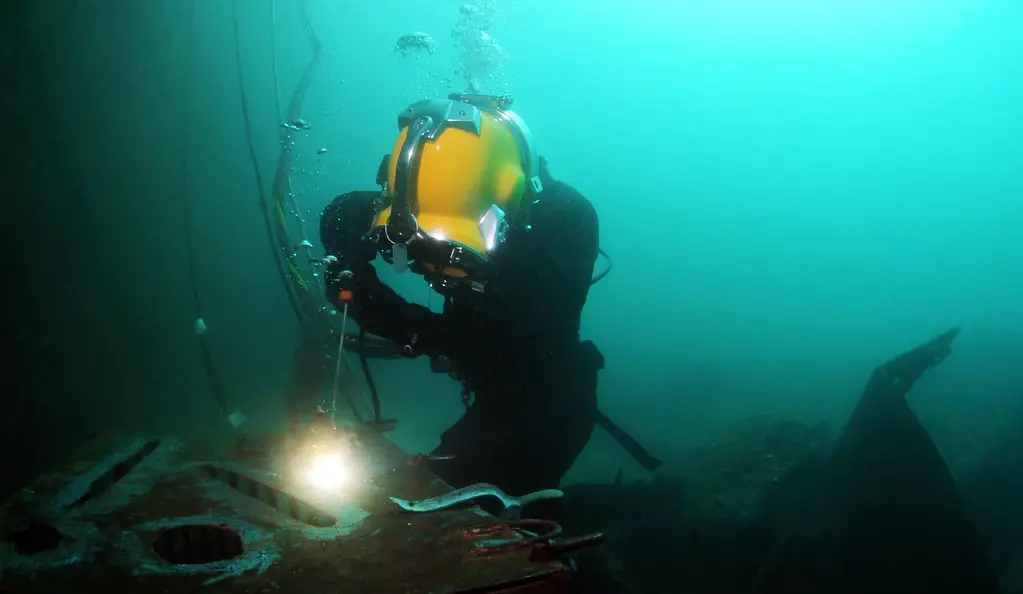Introduction
In 1932, after many successful experiments, a soviet engineer-Konstantin Khrenov travelled to the Black Sea with many other engineers. It was the final testing of coated electrode performing welding at a deep level, and after a successful testing, underwater welding was born. It has numerous applications in World War 2 where there were shortages of metals and nothing could be wasted, so they went underwater to perform welding and lift many enormous ships. Usually classified as one of the most dangerous and taxing jobs in the world and requires a special level of skill set to perform operations underwater. It is also known as hyperbaric welding, which is the process of performing welding at a pressurized level. It is done in the same manner as arc welding is done in air expect 3 factors.
- It is performed under high pressure
- Rapid cooling of water takes place
- Formation of gaseous bubbles that surround or make an envelope around the arc

This task involves a person who can endure extreme mental and physical challenges. However, there are many institutes and certified training centers that can help someone to be professional in this field. Underwater welders work in various industries such as Automobiles, Marines, Construction, Electrical, and many more. They are responsible for monitoring and repairing various pipelines, ships, dams, off- shore oil drilling rigs, nuclear power facilities, etc.
Before going on to the hazards or dangers of underwater welding, let’s understand briefly the classification of underwater welding.
Classification of Underwater Welding
1. Wet Welding-
In this, the equipment is directly exposed to the wet environment, and this practice is mostly considered as the last resort. Proper insulation and DC current with a safety switch is implied for safety purposes and to avoid electrocution. Divers typically use about 300-400 amps of direct current to power the electrode. This is comparatively cheaper and more dangerous than dry welding.
2. Dry Welding-
A dry chamber, also known as Habitat, is constructed around the area which needed to be weld and sealed to avoid the entrance of water in the vicinity. The chamber can be of any size and shape and pressurized slightly above the atmospheric pressure. Certain inert gases like Helium, Oxygen, and Argon are blown into the chambers to maintain a sustainable environment in the habitat , and which also avoid the accumulation of nitrogen gas inside chamber. The source of power supply can be AC or DC.
Also Read:
- Different Types of Welding Joints
- What is Welding Defects – Types, Causes and Remedies?
- Plasma Arc Welding Process- Principle, Main Parts, Working, Advantages and Disadvantages with Application
Threats Faced by Underwater Welders
The various threats or underwater welding dangers are as follows:
1. Delta P
It is one of the most dangerous hazards a welder could face which hit so suddenly that you won’t get a second chance to think about. It is also known as differential pressure. You can’t see or feel the delta P situation until you dive near that. It grabs you suddenly, and doesn’t let go until the pressure is equalize. Everything moves towards stability. So when 2 bodies of water continuously seek to equalize themselves or when they intersect with each other, they create a pressure difference.
Let’s suppose a welder went deep underwater, and there is a drainage or opening into another body. At the moment when the welder came in contact to the open drain his/her body makes a perfect seal against the drain and soon after will run out of oxygen and drowned.
2. Explosion
the formation of gaseous pockets from the combination of hydrogen and oxygen gases can lead to a deathly explosion if it gets ignited. Initially, these pockets create a small popping sound which indicates that hydrogen and oxygen bubbles are accumulating. In this scenario, a welder needs to locate and rectify the place from where these gases are coming out.
3. Decompression Sickness
while understanding this let’s put a background image of opening of a coke can. As a welder goes down underwater the partial pressure of the nitrogen in breathing gets higher. Our body doesn’t use this inert gas for metabolic activities, so this gas gets accumulated and saturated into tissues. As a welder ascends too quickly from high pressure zone to low pressure, the nitrogen starts coming out from the tissues. This can cause big bubbles to form in the tissues and block the blood vessels and could cause paralysis attack or certainly lead to death.
This condition occurs when the diver ascends to the surface too quickly, that means from high pressure zone to the low pressure zone. So to avoid this, ascends should be in control. The ascending speed should never be more than the 10m/min.
4. Electrocution
It is also a big threat to underwater welders. Unique coating and waterproof equipments must be used to avoid this risk.
5. Hypothermia
When the body is subjected to a low temperature underwater, the cold water conducts heat away from the body. The loss of heat can cause organ failure if the body remains too cold for too long. Wearing a well insulated diving gear protects the body from these exposures.
6. Underwater Wildlife
The underwater world is surrounded by many big giants such as whales, sharks, etc. that can harm, not commonly, if you are not conscious.
Here you have learned about the various underwater welding dangers that a welder faces. If you found this information valuable then don’t forget to like and share it.





